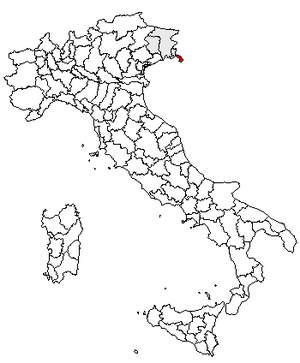Province of Trieste facts for kids
Quick facts for kids
Province of Trieste
Trieste
|
|
|---|---|
 |
|
| Country | |
| Region | Friuli-Venezia Giulia |
| Capital | Trieste |
| Area | |
| • Total | 212 km2 (82 sq mi) |
| Population
((2004))
|
|
| • Total | 240.000 |
| • Density | 1.132/km2 (2.93/sq mi) |
| Postal Code |
34000-34100
|
| Telephone prefix |
040
|
| ISTAT | 032 |
| Vehicle registration | TS |
| No. of communes | 6 |
The Province of Trieste was a special area in the Friuli-Venezia Giulia region of Italy. It was like a small state within Italy. The main city and capital was Trieste.
This province covered about 212 square kilometers (82 square miles). In 2016, around 234,668 people lived there. It also had a coastline of about 48.1 kilometers (29.9 miles).
The Province of Trieste was made up of 6 smaller towns or areas called communes.
Contents
A Look at Trieste's Past
Early Times
After the Western Roman Empire ended, different groups ruled the Trieste area. These included the Ostrogoths, Byzantines, Lombards, and Franks.
In the 1200s, the Habsburg family took control. They divided the land among local lords. These lords were from Duino, Trieste, San Dorligo della Valle, and Muggia.
Later, leaders like Maria Theresa of Austria and Joseph II helped trade grow. They made Trieste a free port, which meant ships could trade there without paying many taxes.
In 1809, France took over the area after beating Austria in a war. When France was finally defeated, some towns like Duino and Aurisina joined Gorizia and Gradisca. Trieste became a special city directly under the Austrian Empire. Other towns like San Dorligo della Valle and Muggia became part of Istria.
World War I did not cause much damage to the province itself. However, very fierce battles were fought nearby, just to its northwest.
Italy took control of the whole area in November 1918. This happened after Austria lost World War I. The area officially became part of Italy with the Treaty of Rapallo in 1920. This treaty also gave Italy all of the former Austrian Littoral region.
How the Province Was Formed
The Province of Trieste was first created in 1920. It included the area we know today. It also had large parts of the Kras plateau and Inner Carniola, which are now in Slovenia.
From 1923 to 1943, the province grew even bigger. It included towns like Monfalcone and Grado, which are now in the Province of Gorizia. It also had many areas that are now part of Slovenia. These included Sežana, Divača, Postojna, and Pivka. Some parts of Koper, Slovenia, were also included.
After World War II
After World War II, a new area called the Free Territory of Trieste was set up. It was like a small independent country. This happened on September 15, 1947.
On October 26, 1954, Italy and Yugoslavia made an agreement. They decided to divide the territory. "Zone A" became the new Province of Trieste, controlled by Italy. "Zone B" was managed by Yugoslavia.
The Province of Trieste officially became part of Italy on October 11, 1977. This was made final by the Treaty of Osimo.
The Province of Trieste was officially ended on September 30, 2017.
Languages Spoken in Trieste
Most people in the province speak Italian. In the city of Trieste, many also speak Triestine. This is a special way of speaking that comes from the Venetian language.
Long ago, people in Trieste and Muggia spoke Tergestine. This was an old dialect of Friulian. However, it completely disappeared by the mid-1800s.
About 8% of the people in the province speak Slovene. This is about 25,000 people, based on a 1971 count.
Italian laws protect the Slovene language. This means it is recognized in all six towns of the province. However, you might not see signs in both Italian and Slovene in the center of Trieste or in Muggia.
Besides standard Slovene, three different Slovene dialects are spoken here:
- The Karst dialect is used in Duino-Aurisina and Sgonico. It is also spoken in parts of Trieste like Barcola and Prosecco.
- The Inner Carniolan dialect is spoken in Monrupino. You can also hear it in Trieste areas like Opicina and Basovizza.
- The Istrian dialect is spoken in San Dorligo della Valle and in the countryside around Muggia. It is also heard in southern parts of Trieste, like Servola.
See also
 In Spanish: Provincia de Trieste para niños
In Spanish: Provincia de Trieste para niños


